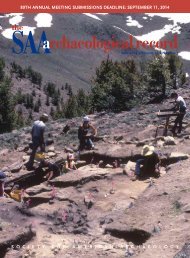SAA
Nov2016_web
Nov2016_web
You also want an ePaper? Increase the reach of your titles
YUMPU automatically turns print PDFs into web optimized ePapers that Google loves.
VIDEO GAMES AND ARCHAEOLOGY<br />
TOWARD ARCHAEOLOGICAL TOOLS<br />
AND METHODS FOR EXCAVATING<br />
VIRTUAL SPACES<br />
Andrew Reinhard<br />
Andrew Reinhard is the director of publications, American Numismatic Society, and the founder of archaeogaming.com.<br />
The prospect of “digging” as an archaeologist within a<br />
virtual world is a paradox: how do we excavate something<br />
that’s not really there? In considering the material<br />
culture of the immaterial, we must completely divorce<br />
ourselves from thinking of archaeogaming as another kind<br />
of “dirt” archaeology. We need a new set of tools to use that<br />
are the equivalent of the pick, spade, trowel, and brush, but<br />
for a space populated by pixels and sprites. Classic, realworld<br />
requirements as elementary as measuring become<br />
complex within the gaming space. Taking levels, recording<br />
GPS points, and even photography operate differently in this<br />
new dimension. As archaeologists operating in the virtual<br />
world, we not only need to define the questions that need<br />
answering but we also need to create a methodology for<br />
“excavation” that can be shared across platforms and games<br />
of all varieties. This article attempts to articulate the first unified<br />
methodology for actual archaeological survey/excavation<br />
conducted within video games, defining the tools needed<br />
and a new kind of mathematics to understand and explain<br />
virtual topography and topology.<br />
Tools<br />
Field archaeologists in the real world use some (or all) of the<br />
following tools in their day-to-day on site: shovel, trowel,<br />
screen, brush/dustpan, dental pick, pickax, tape measure,<br />
line level, plumb bob, camera, computer, notebook,<br />
transit/total station, and drone, as well as remote-sensing<br />
equipment and other specialized tools. Most of these tools<br />
are useless when in a gaming world, unless a game uses<br />
these as part of its archaeology game mechanic where players<br />
can pretend to excavate and recover artifacts.<br />
What about tools used for archaeogaming? At the time of<br />
this writing it’s a computer or console (likely both), a pointing<br />
device, and software for capturing screens, audio, and<br />
video. Services such as Twitch and YouTube Gaming allow<br />
the archaeogamer to live-broadcast an expedition to the public,<br />
as well as host edited videos. Public engagement is a key<br />
to the survival of archaeology anywhere, so having a public<br />
channel for excavating in virtual spaces could be helpful. The<br />
YouTube channel Archaeosoup has already made a few<br />
attempts at broadcasting archaeogaming expeditions in real<br />
time including Elder Scrolls V: Skyrim (Archaeosoup Productions<br />
2015a) and The Witcher III (Archaeosoup Productions<br />
2015b).<br />
Newer generation consoles such as Xbox One connect to an<br />
online account, which facilitates the saving of high-definition<br />
pictures and videos captured via voice command or button<br />
shortcut on the handheld controller. Macs and PCs currently<br />
come with screen-capture software as well, and there are forpurchase<br />
programs/apps such as QuickTime Pro and Camtasia<br />
and free apps such as Open Broadcaster Software that<br />
are loaded with professional editing tools. Mobile phones<br />
require still other apps such as Bluestacks for image- and<br />
motion-capture. Still images are just as important in<br />
archaeogaming as they are to real-world archaeology. The difference<br />
between the two is with the need for motion-capture.<br />
Even the oldest games contain moving parts within a context<br />
embedded with dynamic landscapes and sound. Still images<br />
contain only partial information.<br />
For modern games, archaeogamers share something with<br />
their real-world counterparts: drones. Games such as World<br />
of Warcraft contain fully controllable flying mounts (i.e.,<br />
creatures the player rides; Figure 1), while other games such<br />
as Minecraft allow players to fly and hover. The desire and<br />
ability to view sites from above is not new and was perhaps<br />
best practiced by the team of J. Wilson and Eleanor Emlen<br />
Myers in the 1980s and 1990s (Myers and Myers 1995).<br />
November 2016 • The <strong>SAA</strong> Archaeological Record<br />
19




